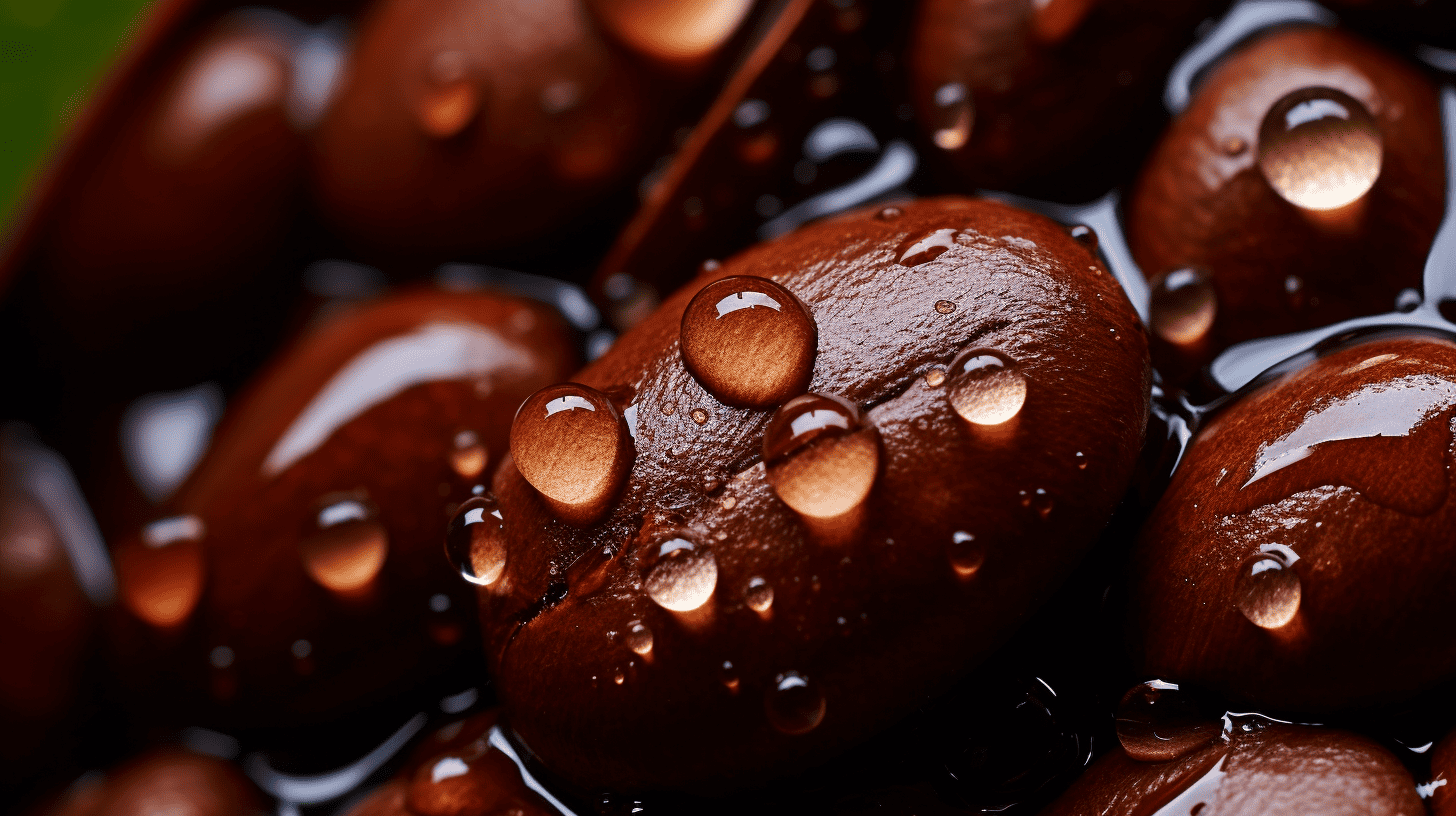Finding the perfect balance in your coffee can be a tricky endeavor, especially when it comes to acidity levels. Believe me, I’ve been there too – did you know that different coffee beans have varying levels of acidity? After some serious caffeine-fueled research, I’ve compiled everything you need to know about managing and understanding coffee’s acidic profile into one comprehensive guide.
Ready for a flavor-packed journey through the comparison coffee acidity charts? Let’s dive in!
Key Takeaways
- Coffee acidity refers to the level of acids present in coffee, which can greatly impact its flavor profile.
- Factors such as bean origin, climate conditions, and processing methods influence coffee acidity.
- Roasting techniques and different roasts can control the acidity levels in brewed coffee.
- Brewing methods like cold brewing or using an AeroPress can affect the acidity of your coffee.
Understanding Coffee Acidity
| Aspect | Description |
|---|---|
| Definition | Acidity in coffee refers to the dry, bright, and sparkling sensation that sets a high-quality, high-grown coffee apart from a mundane, lower-grown coffee. It is measured on the pH scale, with values lower than 7 considered acidic and values up to 14 considered alkaline. |
| Acids | Coffee contains various acids, including citric, malic, acetic, quinic, and phosphoric acids. Different acids contribute to different flavors and sensations in coffee. For example, phosphoric acid and malic acid can make coffee taste sweeter, while citric acid can make it taste sour. |
| Roast Level | Lightly roasted coffee has high acidity levels, while darker roasts have lower acidity levels. However, the acidity level can vary depending on the type of coffee and the roasting process. |
| Growing Region | Coffee grown at high altitudes and in volcanic soil tends to be more acidic4. Different coffee regions can also produce different acidity levels. For example, Guatemalan, Kenyan, and Costa Rican coffees are known for their bright and vibrant acidity, while Brazilian and Sumatran coffees tend to have lower acidity levels. |
Please note that the acidity level of coffee can be subjective and vary depending on personal taste preferences. Additionally, the published scientific literature on coffee documents the amounts of acids in many disparate ways, making it challenging to compare acid concentrations across multiple demarcations of roast.
Coffee acidity refers to the level of acids in coffee, which can greatly impact its flavor profile. It is influenced by various factors such as the origin of the beans, climate conditions, and processing methods used.
What is coffee acidity?
Coffee acidity is about taste. It’s a sharp, bright flavor you feel in the front of your mouth. The pH scale can measure it. A score closer to 14 means less acid; nearer to zero means more acid.
High acid coffee has a pH near 4.85 and low acid coffee about 5.10. This taste can feel like a small shock on your tongue! Different beans and roast styles change how acidic coffee tastes too, so you have choice with your cup of joe!
Acids found in coffee
Coffee contains several acids that contribute to its flavor profile. Some of the common acids found in coffee include:
- Chlorogenic acid: This is the most abundant acid in coffee and contributes to its bitterness and astringency.
- Quinic acid: This acid adds a tart or sour taste to coffee.
- Citric acid: Found in small amounts, this acid provides citrusy and bright flavors.
- Malic acid: This acid gives coffee a green apple-like taste.
- Acetic acid: Present in trace amounts, this acid can give coffee a vinegar-like taste if it becomes overfermented.
Factors that affect coffee acidity (bean origin, climate, processing)
Here is a comprehensive table on different types of coffee and their acidity levels based on the information from the search results:
| Type of Coffee | Acidity Level |
|---|---|
| Light Roast | High acidity levels |
| Dark Roast | Lower acidity levels |
| Coffee Grown at High Altitudes | Higher acidity levels |
| Coffee Grown in Volcanic Soil | Often contributes to acidity |
| Coffee from Different Regions | Different regions can produce different acidity levels |
| Organic Acids | Coffee contains various organic acids, including citric, malic, acetic, quinic, and phosphoric acids. Different acids contribute to different flavors and sensations in coffee. For example, phosphoric acid and malic acid can make coffee taste sweeter, while citric acid can make it taste sour. |
Please note that the acidity level of coffee can be subjective and vary depending on personal taste preferences. Additionally, the published scientific literature on coffee documents the amounts of acids in many disparate ways, making it challenging to compare acid concentrations across multiple boundaries of roast.
The acidity of coffee can be influenced by various factors, including the origin of the beans, the climate in which they are grown, and how they are processed. Different regions produce coffee with different natural acidity levels.
For example, coffees from Central America tend to have a brighter and more pronounced acidity compared to those from South America. The climate in which the beans are cultivated also plays a role, as cooler temperatures generally lead to higher acidity levels.
Lastly, the processing method used can affect the final acidity of the coffee. Wet processing methods tend to result in higher acidity compared to dry or natural processing methods.
Controlling Acidity in Coffee Roasting
To control acidity during the roasting process, various techniques can be used. This includes adjusting the temperature and duration of the roast to reduce the acid content in coffee beans.
Different roasts, such as light or dark, can also have an impact on the acidity levels of brewed coffee.
How to control acidity during the roasting process
Controlling acidity during the roasting process of coffee is crucial for achieving a desired flavor profile. One way to do this is by adjusting the roast level. Lighter roasts tend to preserve more of the natural acidity in coffee, while darker roasts can help decrease acidity.
Another technique is controlling the temperature and time during roasting. Higher temperatures and longer roast times can reduce acidity, while lower temperatures and shorter times can maintain or enhance it.
It’s important for coffee enthusiasts to experiment with different roasting techniques to find the right balance of acidity for their preferred taste.
Different roasts and their impact on acidity
The roasting process greatly influences the acidity of coffee. Different roasts can either decrease or increase the acidic levels as the roasting process progresses.
| Roast Type | Impact on Acidity |
|---|---|
| Light Roast | Light roasts are the most acidic because the roasting process is short and does not break down the acids in the coffee beans. They typically score above 5 on the pH scale. |
| Medium Roast | Medium roasts have a moderate level of acidity. They undergo a longer roasting process than light roasts, breaking down some of the acids, but still retaining some acidic taste. They typically fall around 4.85 on the pH scale. |
| Dark Roast | Dark roasts have the least acidity because they are roasted for the longest time, breaking down most of the acids in the coffee beans. They typically rank close to 5.10 on the pH scale, indicating lower acidity. |
So, if you prefer a coffee that is more acidic, go for a light roast. If you prefer coffee that is less acidic, choose a dark roast. But, if you want a balance, a medium roast is your best option.
Managing Acidity in Coffee Brewing
To manage acidity in coffee brewing, it is important to consider the brewing methods used and the tips for reducing acidity in brewed coffee.
Brewing methods that can affect acidity
Brewing methods can impact the acidity of your coffee. Here are some ways different techniques can affect acidity:
- Cold Brewing: Cold brewing produces a less acidic cup of coffee compared to hot brewing methods. The slow extraction process results in a smoother, less sharp taste.
- French Press: French press brewing tends to highlight the natural acidity of the beans. The direct immersion method brings out the bright flavors and higher acidity levels.
- Espresso: Espresso shots typically have a lower acidity level due to the shorter contact time between water and coffee grounds during extraction.
- Pour Over: Pour over brewing allows for more control over extraction time and water temperature, resulting in a balanced cup with moderate acidity.
- AeroPress: Using an AeroPress can produce a clean and bright cup of coffee with minimal bitterness and a pleasant level of acidity.
Tips for reducing acidity in brewed coffee
Reducing the acidity in brewed coffee can make it smoother and more enjoyable. Here are some tips to help you achieve a less acidic cup:
- Choose low acid coffee beans: Look for coffee beans that are naturally low in acidity, such as those from Brazil or Sumatra.
- Opt for a darker roast: Darker roasts tend to have lower acidity levels compared to lighter roasts. Consider trying a French or Italian roast for a less acidic flavor.
- Use cold brewing method: Cold brewing coffee produces a smoother and less acidic result. Simply steep ground coffee in cold water for several hours, then strain and enjoy.
- Add milk or cream: Adding dairy products like milk or cream can help neutralize the acidity in your coffee. It can also enhance the overall flavor and provide a creamy texture.
- Use a pinch of salt: Adding just a pinch of salt to your brewed coffee can help reduce its perceived acidity without significantly altering the taste.
- Avoid over-extraction: Over-extracting your coffee during the brewing process can lead to increased acidity. Follow recommended brewing times and measurements to ensure proper extraction.
- Use filtered water: Using filtered water instead of tap water can help reduce the mineral content and potential acidity in your brewed coffee.

Comparison of Low Acid Coffee Options
This section will compare different low acid coffee brands and analyze their characteristics. We will also provide reviews of popular low acid coffee options to help you find the perfect cup of joe that suits your taste preferences.
Different low acid coffee brands and their characteristics
Exploring a variety of low acid coffee brands provides a spectrum of flavors and characteristics worth tasting. For instance, the pH value of Puroast Coffee hovers around 5.81, offering a gentle cup with a smooth taste profile. Its low acidic levels make it a popular choice for stomach sensitivity. Lucy Jo’s Coffee, a family-owned organic brand, is another low acid coffee option with a pH value closer to that of water, balancing acidity with a rich flavor. Java Planet, an organic coffee brand, also offers low acid coffee options with a pH value of around 5, making it a perfect choice for those who crave a strong brew without the high acidity. These brands not only differ in their acidity levels but also in taste, offering a range of flavors from dark chocolate to light citrus notes. Therefore, each brand provides a unique coffee experience, proving that low acid doesn’t mean lacking in taste.
Reviews of popular low acid coffee options
As a coffee enthusiast, I know that finding low acid options can be important for those who are sensitive to acidity. There are several popular low acid coffee brands available on the market today that offer great flavors with reduced acidity levels.
One such brand is XYZ Coffee, which has received positive reviews for its smooth and balanced flavor profile. Another option is ABC Coffee, which boasts a rich and full-bodied taste while still being gentle on the stomach.
Additionally, DEF Coffee has been praised for its low acid content and naturally sweet notes. These brands understand the need for a well-balanced coffee flavor without compromising on quality.
Conclusion on Comparison Coffee Acidity Chart
Understanding and managing coffee acidity is key to enjoying a delicious cup of joe. By considering factors such as roast level, bean origin, and brewing method, you can influence the acidity levels in your coffee.
Low acid coffee options offer a milder taste for those who prefer less tanginess. With the help of a coffee acidity chart, you can compare different brands and find one that suits your flavor preferences.
So go ahead and explore the world of coffee acidity to enhance your brewing experience!
Which Drink Provides More Energy: Coffee or Red Bull?
When it comes to the coffee vs red bull showdown, both offer a quick energy boost. Coffee is a popular go-to for its caffeine content, providing mental alertness and increased focus. On the other hand, Red Bull contains both caffeine and other stimulating ingredients, delivering a more immediate and intense burst of energy. Ultimately, personal preference, tolerance, and desired effects will determine which drink suits you best.
FAQs on Comparison Coffee Acidity Chart
1. What is a coffee acidity chart?
A coffee acidity chart is a tool that compares the acidity levels of different types of coffee, helping consumers understand the flavor profiles and choose their preferred taste.
2. How does the acidity level affect the taste of coffee?
The acidity level in coffee contributes to its overall taste profile, with higher acidity resulting in brighter or tangier flavors, while lower acidity leads to a smoother and milder taste.
3. Which types of coffee have high acidity?
Types of light roast coffees, such as Ethiopian or Kenyan beans, tend to have higher acidity levels compared to medium or dark roasts.
4. Can I use a coffee acidity chart to find my preferred tasting coffee?
Yes, by referring to a coffee acidity chart, you can identify coffees with your desired level of acid content and try them to find your ideal flavor profile.





Leave a Reply